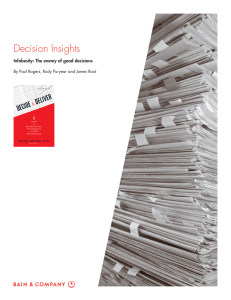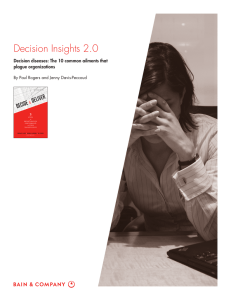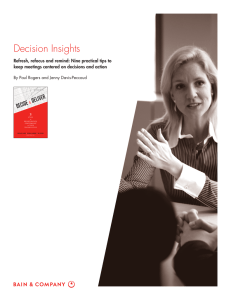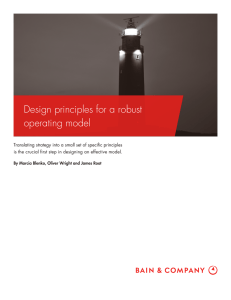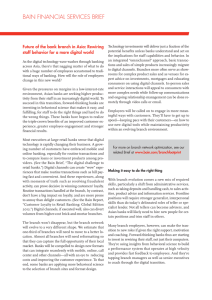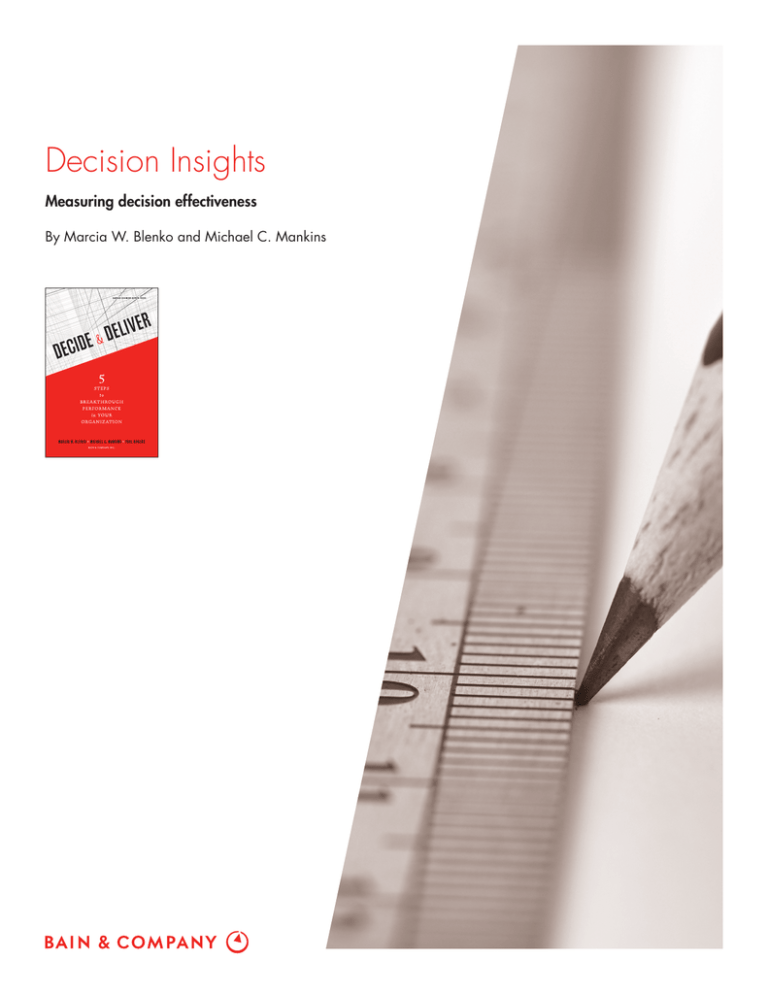
Decision Insights
Measuring decision effectiveness
By Marcia W. Blenko and Michael C. Mankins
Measuring decision effectiveness
Good, fast decision making and execution produce good
financial results.
measurement shows that your decision skills are way
behind where they should be, suddenly you have a big
incentive to get better.
The research we conducted for our recent book firmly
established this connection, but really, it’s only common
sense.1 Companies that make high-quality decisions, make
them quickly, and implement them effectively win more
contracts, get to market faster and otherwise beat out rivals.
Google launched Gmail, Google+, the Android operating
system, and Google Apps, all while Yahoo! was struggling
to decide on its priorities in these areas. Such dramas play
out on a smaller scale in every company every day. Organizations that decide and execute better and faster than their
competitors win the race.
Decision effectiveness involves four different dimensions.
High-performing organizations, of course, make highquality decisions. But they also make those decisions faster
than their competitors, translate them into action more
effectively and devote an appropriate amount of effort to
the process. People need to know how well (or poorly)
they perform on all of these elements—decision quality,
speed, yield and effort.
Employee surveys are the best gauge of performance on
each dimension, since no one knows better than the
people involved how good the organization really is. Ask
respondents to rate your company’s abilities on quality,
speed, yield and effort using a 1-to-4 point scale; this will
allow you to compare scores with our benchmark database
of high, average, and low performers (see Figure 1). The
results will show you where your decision strengths
and weaknesses lie, and what you need to do to improve
performance. A pharmaceutical company, for instance,
learned from a survey that its decisions were generally of
And yet many companies do not even measure their decision
effectiveness. They don’t know how they stack up against
the competition, and they can’t tell whether they are getting
better or worse over time. People may gripe in the hallways
about this or that decision process, but there’s no burning
platform to stimulate improvement.
Measurement changes all that. As Peter Drucker famously
observed, “What gets measured gets managed.” And if the
Figure 1: Benchmarking your company’s decision effectiveness can help you focus on the right issues
x
Quality
“How often do you
choose the right
course of action?”
Speed relative to competitors
100%
Company
80
80
Slower than… On par with…
64
60
48
40
20
0
Mid
Faster than…
% right decisions
Low
x
Speed
High
100%
80
70
60
40
“How often do you
execute decisions
as intended?”
Effort “tax” for suboptimal
amount of effort
100%
25%
79
80
“Lower
is better”
20
16
62
15
12
45
39
20
0
40
10
20
5
0
Low
Effort
“Do you put the right amount
of effort into making and
executing decisions?”
% effective execution
60
54
Yield
“How quickly do you make
decisions compared with your
competitors?”
Mid
High
9
0
Low
Mid
High
Decision effectiveness benchmarks
Note: High decision effectiveness range = top quintile of decision effectiveness scores; Low = bottom quintile; Mid = all other
Source: Bain decision and org effectiveness survey Jan 2012 (n=1,065)
Low
Mid
High
Measuring decision effectiveness
high quality compared with its competitors, but its speed
was below average, and nearly 80% of respondents said
that decisions required too much effort. The priorities for
improvement were clear. Once a company launches efforts
to improve its decision effectiveness, moreover, regular
surveys can provide critical feedback to show you what’s
working and what isn’t.
with developing new products—to determine the number
of decisions each forum made, the number of decisions
it delayed, and the number it revisited over a given time
period. The company also tracked the frequency of escalation to a decision maker higher up in the organization.
The data helped people learn to increase decision speed,
cut back on reconsiderations, and reduce escalations.
While survey results provide a high-level overview of a
company’s decision effectiveness, it helps to supplement
this data with metrics that relate to specific trouble spots.
Among them are the following.
Performance on certain kinds of decisions. Some organizations repeatedly stumble over particular types of
critical decisions. Another pharmaceutical company, for
example, found that sluggish decision procedures slowed
its stage-gate process for product development, creating
unnecessary iterations along the way. The data helped the
company spot and unclog decision bottlenecks and thus
get its products to market faster. A utility company learned
that its forecasts of daily demand were often off the mark.
So it began tracking the percentage of forecasting decisions that, with hindsight, turned out to be right. The
process helped the executives responsible for forecasting
to see where their procedures were strong and what
actions could help improve them.
Decision competencies and behaviors. Companies can
assess individuals’ decision-making skills in their regular
performance evaluations. They can also track the behaviors that are central to effective decision making and
execution, such as people’s willingness to engage in open
and constructive debate or their willingness to commit
to a decision even when they disagree with it. For example,
a tech company established a list of such behaviors
and began measuring them through its annual upward
feedback system. A financial services company tracked
adoption of its desired decision behaviors through quarterly “pulse” surveys. Several companies link executives’
bonuses to a range of decision metrics, including overall
quality, speed, yield and effort; specific behaviors measured through employee surveys; and performance against
established leadership standards. Both the measurements
and the incentives encourage individuals to develop their
own decision skills and to build organizations that make
and execute decisions well.
What happens in meetings. Meetings should be effective
forums for discussing or making decisions, but often they
are not. So top-performing companies make a point of
setting decision-focused agendas, beginning meetings
by specifying the decisions to be made and who is accountable for them, ensuring that committees have clear
decision charters, and so on. Then they measure performance on these dimensions. A semiconductor company,
for instance, tracked its R&D forums—groups charged
Drucker’s dictum about measurement and management is by now an accepted part of management lore. The
challenge it presents is to measure “soft” but critical
aspects of a business’s operation, such as decision effectiveness. Some companies have met this challenge
head-on and are reaping the rewards. They not only
invest to improve their decision effectiveness, but they
also measure how well those efforts generate better, faster
decisions and thus better performance.
1
See Marcia W. Blenko, Michael C. Mankins, and Paul Rogers, Decide and Deliver: 5 Steps to Breakthrough Performance in Your Organization (Harvard Business Review Press, 2010).
Marcia W. Blenko is a partner with Bain & Company and leads the firm’s Global Organization practice. Michael
C. Mankins leads Bain’s Organization practice in the Americas and is a key member of Bain’s Strategy practice.
He is a partner in the firm’s San Francisco office.
Copyright © 2012 Bain & Company, Inc. All rights reserved.
Shared Ambit ion, True Results
Bain & Company is the management consulting firm that the world’s business leaders come to when
they want results.
Bain advises clients on strategy, operations, technology, organization, private equity and mergers and acquisitions. We develop
practical, customized insights that clients act on and transfer skills that make change stick. Founded in 1973, Bain has 48 offices
in 31 countries, and our deep expertise and client roster cross every industry and economic sector. Our clients have outperformed
the stock market 4 to 1.
What sets us apart
We believe a consulting firm should be more than an adviser. So we put ourselves in our clients’ shoes, selling outcomes, not
projects. We align our incentives with our clients’ by linking our fees to their results and collaborate to unlock the full potential of
their business. Our Results Delivery® process builds our clients’ capabilities, and our True North values mean we do the right
thing for our clients, people and communities—always.
For more information, visit www.decide-deliver.com
For more information about Bain & Company, visit www.bain.com





